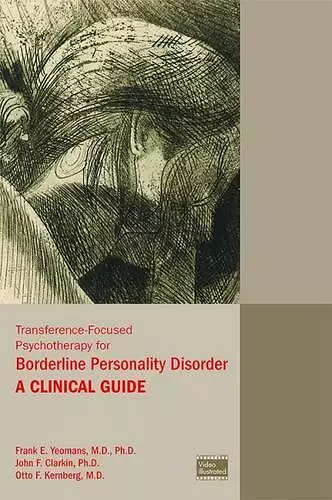Transference-Focused Psychotherapy for Borderline Personality Disorder
A Clinical Guide
Otto F Kernberg author Frank E Yeomans author John F Clarkin author
Format:Paperback
Publisher:American Psychiatric Association Publishing
Published:28th Feb '15
Should be back in stock very soon

Transference-Focused Psychotherapy for Borderline Personality Disorder: A Clinical Guide presents a model of borderline personality disorder (BPD) and its treatment that is based on contemporary psychoanalytic object relations theory as developed by the leading thinker in the field, Otto Kernberg, M.D., who is also one of the authors of this insightful manual. The model is supported and enhanced by material on current phenomenological and neurobiological research and is grounded in real-world cases that deftly illustrate principles of intervention in ways that mental health professionals can use with their patients.
The book first provides clinicians with a model of borderline pathology that is essential for expert assessment and treatment planning and then addresses the empirical underpinnings and specific therapeutic strategies of transference-focused psychotherapy (TFP).
• From the chapter on clinical assessment, the clinician learns how to select the type of treatment on the basis of the level of personality organization, the symptoms the patient experiences, and the areas of compromised functioning. In order to decide on the type of treatment, the clinician must examine the patient's subjective experience (such as symptoms of anxiety or depression), observable behaviors (such as investments in relationships and deficits in functioning), and psychological structures (such as identity, defenses, and reality testing).
• Next, the clinician learns to establish the conditions of treatment through negotiating a verbal treatment contract or understanding with the patient. The contract defines the responsibilities of each of the participants and defines what the reality of the therapeutic relationship is.
• Techniques of treatment interventions and tactics to address particularly difficult clinical challenges are addressed next, equipping the therapist to employ the four primary techniques of TFP (interpretation, transference analysis, technical neutrality, and use of countertransference) and setting the stage for and guiding the proper use of those techniques within the individual session.
• What to expect in the course of long-term treatment to ameliorate symptoms and to effect personality change is covered, with sections on the early, middle, and late phases of treatment. This material prepares the clinician to deal with predictable phases, such as tests of the frame, impulse containment, movement toward integration, episodes of regression, and termination.
• Finally, the text is accompanied by supremely instructive online videos that...
This book is well worth the time and attention of residents, practicing psychiatrists, and other mental health clinicians whether they are new to therapy, new to psychodynamic therapy, or experienced therapists. Although I have been practicing for close to 40 years, I learned new things from it, and I have already recommended the volume to colleagues who are eager to begin learning in greater depth about psychodynamic theory and the technique of therapy. My advice was to get into the book, take it seriously, and work away at it. For those with the ability to do so, making it the work of a reading group to support each other's learning, or with a supervisor, or both, may make sense. And the authors also offer TFP courses online and at various sites around the country.
-- Eric M. Plakun, M.D., Associate Medical Director and Director of Biopsychosocial Advocacy, Austen Riggs Center, Stockbridge, MA, and Leader of the American Psychiatric Association Psychotherapy Caucus, Arlington, VA * Journal of Psychiatric Practice Vol. 23, No.ISBN: 9781585624379
Dimensions: 229mm x 152mm x 27mm
Weight: 680g
427 pages